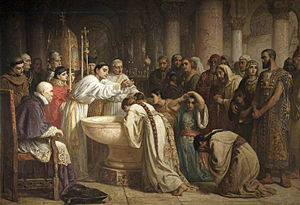
Back التحول الديني القسري لمسلمي إسبانيا Arabic Prisilno pokrštavanje muslimana Španije BS Conversions forçades als regnes hispànics Catalan Conversiones forzadas de musulmanes en España Spanish گرویدن اجباری مسلمانان در اسپانیا Persian Conversion forcée des musulmans d'Espagne French Pemindahan agama paksa umat Islam di Spanyol ID Pamasoan agamo Katolik ka umat Islam di Spanyol MIN Murtad paksa orang Islam di Sepanyol Malay Conversões forçadas de muçulmanos na Espanha Portuguese

The forced conversions of Muslims in Spain were enacted through a series of edicts outlawing Islam in the lands of the Spanish Monarchy. This persecution was pursued by three Spanish kingdoms during the early 16th century: the Crown of Castile in 1500–1502, followed by Navarre in 1515–1516, and lastly the Crown of Aragon in 1523–1526.[1]
After Christian kingdoms finished their reconquest of Al-Andalus on 2 January 1492, the Muslim population stood between 500,000 and 600,000 people. At this time, Muslims living under Christian rule were given the status of "Mudéjar", legally allowing the open practice of Islam. In 1499, the Archbishop of Toledo, Cardinal Francisco Jiménez de Cisneros began a campaign in the city of Granada to force religious compliance with Christianity with torture and imprisonment; this triggered a Muslim rebellion. The rebellion was eventually quelled and then used to justify revoking the Muslims' legal and treaty protections. Conversion efforts were redoubled, and by 1501, officially, no Muslim remained in Granada. Encouraged by the success in Granada, the Castile's Queen Isabella issued an edict in 1502 which banned Islam for all of Castile. With the annexation of the Iberian Navarre in 1515, more Muslims still were forced to observe Christian beliefs under the Castilian edict. The last realm to impose conversion was the Crown of Aragon, whose kings had previously been bound to guarantee the freedom of religion for its Muslims under an oath included in their coronations. In the early 1520s, an anti-Islam uprising known as the Revolt of the Brotherhoods took place, and Muslims under the rebel territories were forced to convert. When the Aragon royal forces, aided by Muslims, suppressed the rebellion, King Charles I (better known as Charles V of the Holy Roman Empire) ruled that those forcible conversions were valid; thus, the "converts" were now officially Christians. This placed the converts under the jurisdiction of the Spanish Inquisition. Finally, in 1524, Charles petitioned Pope Clement VII to release the king from his oath protecting Muslims' freedom of religion. This granted him the authority to officially act against the remaining Muslim population; in late 1525, he issued an official edict of conversion: Islam was no longer officially extant throughout Spain.
While adhering to Christianity in public was required by the royal edicts and enforced by the Spanish Inquisition, evidence indicated that most of the forcibly converted (known as the "Moriscos") clung to Islam in secret. In daily public life, traditional Islamic law could no longer be followed without persecution by the Inquisition; as a result, the Oran fatwa was issued to acknowledge the necessity of relaxing sharia, as well as detailing the ways in which Muslims were to do so. This fatwa become the basis for the crypto-Islam practiced by the Moriscos until their expulsions in 1609–1614. Some Muslims, many near the coast, emigrated in response to the conversion. However, restrictions placed by the authorities on emigration meant leaving Spain was not an option for many. Rebellions also broke out in some areas, especially those with defensible mountainous terrain, but they were all unsuccessful. Ultimately, the edicts created a society in which devout Muslims who secretly refused conversion coexisted with former Muslims who became genuine practicing Christians, up until the expulsion.
- ^ Harvey 2005, p. 14.
© MMXXIII Rich X Search. We shall prevail. All rights reserved. Rich X Search